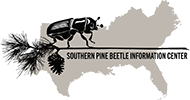Abstract
Southern pine beetle (SPB; Dendroctonus frontalis Zimmerman), a native insect that has historically affected pine (Pinus spp.) ecosystems in the southeastern U.S., has recently expanded northward causing extensive tree mortality in pitch pine (P. rigida) and pitch pine-oak (Quercus spp.) forests of eastern Long Island, NY. Given the historic lack of SPB within this region, little is known regarding its potential impacts. This study examined the immediate effects of SPB-induced tree mortality and management (i.e., cut-and leave suppression) on the structure and composition of affected forest communities to inform management recommendations and projections of future forest conditions. Overstory pine basal area declined significantly following SPB infestation and management (67–100% mortality), although management partly mitigated these effects. There was no immediate impact of SPB or management on seedling and sapling density or composition, with hardwood species making up the majority of this layer and pine representing<6% of stems regardless of mortality agent. Pitch pine was less likely to be browsed by ungulates than white oak and scarlet oak. SPB infestation significantly increased snag basal area, whereas downed woody debris volumes were greatest following management. Understory community composition in pitch pine stands that had SPB or were managed had greater understory plant diversity largely through a higher abundance of disturbance-adapted species. There was less between-site variation in understory species assemblages in pine-oak forests experiencing pitch pine mortality and an increase in regeneration of pitch pine and scarlet oak in these areas. Collectively, the short-term results suggest SPB could functionally eliminate pitch pine from infested stands in the absence of additional management, and that management in pine-oak stands may exacerbate this trend, leading to increasing dominance of hardwoods species in pine barren communities. Based on our results, fuels reduction treatments combined with site-specific restoration of barrens structure and composition may be useful in maintaining stands with lower fire hazard and greater resilience to this new threat.
Keywords
Dendroctonus frontalis, Pinus rigida, Pine barrens, Long Island, Forest regeneration, Coarse woody debris
To read the full article please visit the link below:
Heuss, Molly, Anthony W. D’Arnato, and Kevin J. Dodds. 2019. “Northward Expansion of Southern Pine Beetle Generates Significant Alterations to Forest Structure and Composition of Globally Rare Pinus Rigida Forests.” Forest Ecology and Management 434 (February): 119–30. https://doi.org/10.1016/j.foreco.2018.12.015.
